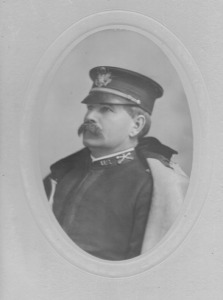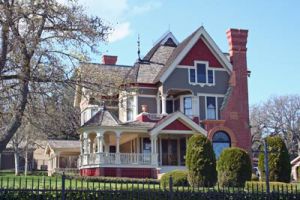Pioneer Profiles – May 2015
Jacksonville’s lovely 1892 Queen Anne-style home on North Oregon Street is best known as the “Nunan House,” named after its original occupants, Jeremiah and Delia Nunan (profiled in the March 2015 issue of the Jacksonville Review). But to Herbert Howland Sargent and Alice Applegate Sargent, its second owners, the house was known as “Casa Grande,” Spanish for “big house,” reflecting their home’s imposing personality and their own history.
Alice and Herbert had met and married in Klamath Falls in 1886. He was 28; she was six years his senior and had been married before. He was a newly-commissioned Lieutenant fresh out of West Point, and Fort Klamath was his first posting. She was the daughter of pioneer explorer Lindsey Applegate and had grown up in the toll station on the mountain road over the Siskiyous. (See April “Pioneer Profiles.”)
Alice had always found life exciting, but she had expected to find that excitement in Oregon and had vowed as a child never to leave it. As a military wife, life took her over much of the U.S. and many parts of the world. It was 32 years before she saw Oregon again.
She followed Herbert on all of his assignments—a rarity given that most military wives did not accompany their men. Her memoirs, Following the Flag, chronicled her experiences.
Fort Klamath was followed by a year’s posting in Illinois, Sargent’s home state, and then an assignment in Northern California. Next was Fort Walla Walla in Washington, 500 miles away and a three week horseback ride. Other duty stations followed in the desert Southwest and South, including a stint at Texas A&M where Herbert was a Professor of Military Science and Tactics.
When the battleship U.S.S. Maine exploded and sank in the port of Havana in 1898 killing 260 crew members, the U.S. declared war on Spain. Sargent was appointed Colonel of the 5th U.S. Volunteer Infantry and ordered to take an army regiment to Santiago, Cuba. Alice went with him, sleeping in a tent in the mud just like the soldiers.
The hot sun, drenching rains, steamy air, snakes and scorpions were minor inconveniences compared to the tropical diseases—malaria, typhoid, yellow fever. Alice contracted the latter from the swarms of mosquitoes, suffering with it for weeks. She was one of the lucky ones who survived, noting in her diary the dense clouds of smoke hanging over the hills where the bodies of yellow fever victims were being cremated. Then Herbert fell ill and lay for weeks at the point of death. Alice nursed him through those “days dark and dreary.”
Once recovered, Sargent was posted to the Philippines to oversee the insurgency that resulted from the Treaty of Paris whereby Spain ceded Puerto Rico, Guam, and the Philippine Islands to the U.S. Of course, Alice went with him. While there, she served as correspondent for an Illinois newspaper, documenting living conditions in Manila for her readers.
Subsequent active duty assignments were interspersed with teaching posts since Herbert was also a teacher and the author of three highly-acclaimed books on military science. His history of The Campaign of Santiago de Cuba earned him a special commendation from President Theodore Roosevelt, whose exploits, along with those of Roosevelt’s “Rough Riders,” were detailed in the book.
Following a stint in South Dakota during the Dakota Ute Campaign, time in Washington D.C. at the Army War College, and another Philippines command, Herbert and Alice retired to Medford in 1911. They became active in civic affairs, with Herbert serving as a Medford City Councilor and as Chairman of the Jackson County Progressive Party; Alice became head of the Leonard Wood Republican Club.
They purchased their “Casa Grande” in 1915.
Then in 1916, Herbert was recalled to World War I active duty, serving in the Quartermaster Department in San Francisco, as Professor of Military Science and Tactics at Princeton University, and on the general staff of the Army War College. Alice tried to enlist in the Nurse Cadet Corps but was told she was too old.
After the Armistice, they retired again to Jacksonville where they became involved once more in community affairs. Then Herbert found he had one more battle to fight. In 1920 there was an attempt to move the Jackson County courthouse from Jacksonville to Medford. Herbert went to war. He planned his strategy and tactics; he wrote articles; he gave speeches. Herbert was victorious…but it was a Pyrrhic victory. Six years later the county seat was moved.
Herbert did not live to see that. In 1921, he dropped dead from a heart attack, running to put out a brush fire on their property. He was buried in the Jacksonville Cemetery with full military honors. Two years after his death, Alice had the stone wall along Cemetery Road built in his memory.
Alice lived for another 13 years and remained involved in Jacksonville activities. She was active in the Native Daughters of Oregon and a founder of their Jacksonville Museum, the forerunner of the Southern Oregon Historical Society.
When Alice joined her husband in the Jacksonville Cemetery in 1934, her years of service were also recognized by the Army. The Spanish American and “Great War” veterans gave her a full military funeral—the first such rites ever accorded a woman.
Pioneer Profiles is a project of Historic Jacksonville, Inc., a non-profit organization whose mission is helping to preserve Jacksonville’s Historic Landmark District by bringing its buildings to life through programs and activities. Visit us at www.historicjacksonville.org and follow us on Facebook (historicjville) for upcoming events and more Jacksonville history.


